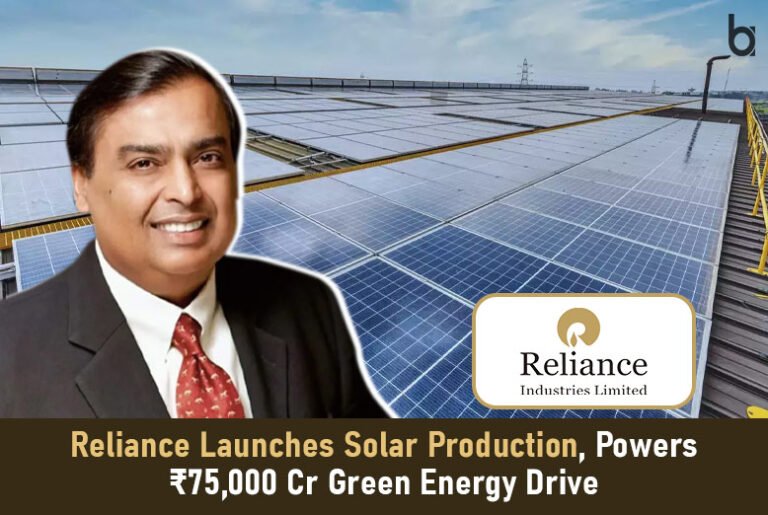Business APAC
April 28, 2025
Reliance Industries Ltd (RIL) has officially commissioned its first 1-gigawatt (GW) solar panel manufacturing line in Jamnagar, Gujarat, marking a concrete step in its massive green energy ambitions. This initial Heterojunction Technology (HJT) line kicks off Reliance Solar Manufacturing plans to build a fully integrated 10 GW facility by 2026, part of a Rs 75,000 crore (approx. $9 billion) investment earmarked for setting up the entire giga factory complex, according to company presentations and officials.
This project falls under RIL’s broader $10 billion new energy vision outlined in 2021, encompassing renewables, battery storage, and hydrogen fuel – all aimed at achieving net-zero carbon emissions by 2035. Chairman Mukesh Ambani noted in the company’s recent FY25 results, “In the coming quarters, we will see the transition of this business from incubation to operationalisation. I firmly believe that the new energy growth engine will create significant value for Reliance, India, and the world.”
Gigafactory Rollout: Solar Begins, Batteries Advance
The newly operational 1 GW line is just the start. Reliance intends to scale rapidly to the full 10 GW integrated capacity by 2026, a move projected to add Rs 6,000 crore to the company’s annual EBITDA. The Reliance Solar Manufacturing initiative Officials reiterated that the design allows for further expansion to 20 GW if market demand warrants.
The panels produced, already certified by BIS, are high-efficiency units generating up to 720 watts peak. “Engineering across the entire value chain — polysilicon to ingot, wafer, cell, and panel — is complete,” an executive confirmed, adding that equipment orders are placed and construction is in full swing across the complex.
Beyond solar, Reliance is advancing its battery manufacturing plans, targeting 30 GW of capacity. The focus is on Lithium Iron Phosphate (LFP) technology using large prismatic cells suited for utility-scale storage. “We are building out the entire value chain, including battery materials,” an executive stated. Construction is underway, with production slated to begin by 2026, starting with battery packs before moving to full cell manufacturing.
Driving National Goals: Energy Targets and ‘Make in India’
This investment aligns with India’s goal of 500 GW non-fossil fuel power capacity by 2030 and supports the ‘Atmanirbhar Bharat’ initiative for domestic manufacturing, especially with a government mandate for local solar components looming in mid-2026. Reliance joins other key Indian firms like Adani Group, Tata Power Solar, Waaree Energies, and Vikram Solar in expanding the nation’s solar manufacturing base. This growth in Reliance Solar Manufacturing contributes significantly.
Integrated Vision and Project Execution
- Company officials stressed the project’s integrated nature. “What’s unique is the full end-to-end integration — from solar to battery to green hydrogen,” a senior executive remarked regarding the Reliance Solar Manufacturing and broader energy scope.
Progress is visible across the board:
- Land secured in Kutch could support nearly 150 billion units of annual electricity generation.
- A dedicated transmission line from Jamnagar is being built.
- 2,000 acres in Kandla are set for a green hydrogen hub anchored by an electrolyser manufacturing joint venture with Nel ASA.
The company also reaffirmed plans to grow its compressed biogas (CBG) operations.
- Reliance CFO V Srikanth indicated the peak capital expenditure phase for telecom (Jio) is past, and the Rs 75,000 crore giga factory setup cost is largely spent or committed.
- Future spending will be more measured, he suggested, with larger investments tied to actual power generation rollout.
- Executives target commissioning for all factories by late 2025 or early 2026, with production starting soon after.
What to expect?
Long-term financial projections see the new energy division potentially matching the profits of the traditional oil-to-chemicals business between 2029 and 2031, eventually contributing over half the company’s consolidated profit. The success of Reliance Solar Manufacturing will be key.
Starting this first GW of solar production signals that Reliance’s multi-billion dollar clean energy strategy, including Reliance Solar Manufacturing, is moving firmly from planning stages into tangible operation, aiming to reshape both the company’s future and India’s energy landscape.
Also Read: Nissan’s financial struggles are worse than anticipated, and the aftermath continues



